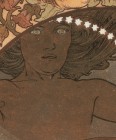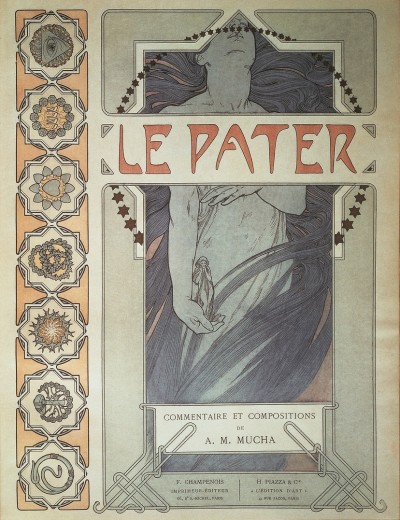
Le Pater (4 works)
Le Pater is an illustrated edition of The Lord’s Prayer created by Mucha. Published in Paris on 20th December 1899 at the passing of the old century, it was meant to be Mucha’s message to future generations about the progress of mankind. Through the archetypal Christian prayer, he wished to present the way for man to reach the Divine Ideal, the highest state in the spiritual world.
Mucha conceived this project at a turning point in his career. According to his own account, Mucha was at that time increasingly dissatisfied with unending commercial commissions and was longing for an artistic work with a more elevated mission. He was also influenced by his long-standing interest in Spiritualism since the early 1890s and, above all, by Masonic philosophy. In January 1898, almost two years before the publication of Le Pater, Mucha was initiated into the Paris Lodge Les Inseparables du Progrès as an apprentice and after the independence of his homeland he was to become the highest representative of the Freemasons of Czechoslovakia. Mucha’s freemasonry was an outcome of his Spiritualism – the pursuit of a deeper Truth beyond the visible world. Through his spiritual journey Mucha came to believe that the three virtues – Beauty, Truth and Love – were the ‘cornerstones’ of humanity and that the dissemination of this message through his art would contribute towards the improvement of human life and, eventually, the progress of mankind.
In order to visualise his vision, Mucha analysed each of the seven verses of the model Christian prayer and reconstructed it in a set of three pages. The first page of each set, in colour, is the relevant verse in French and Latin, framed in a border sumptuously decorated with flowers and a symbolic female figure. The second page, also in colour, is Mucha’s own text, interpreting the verse and decorated with floral patterns. The third monochromatic page, printed in photogravure, contains a full-page allegorical drawing illustrating Mucha’s philosophical response to the verse. Throughout the pages, Mucha’s designs feature an abundance of Masonic symbols. The outcome was an exquisite book published in an edition of 510 copies.
Le Pater was Mucha’s first manifest as an artist-philosopher and he regarded the book as his finest work. In 1900 Mucha exhibited the book and the preparatory drawings at the Paris International Exhibition and was deeply gratified when the illustrations attracted the attention of Emperor Francis Joseph I.




